While outdoor gardens require significant space and sunlight, your bedroom can become a thriving indoor jungle with the right choice of vines. You’ll discover how ten low-maintenance climbing plants can transform bare walls and empty corners into lush, air-purifying displays. From the foolproof Pothos to the exotic Philodendron Brasil, these carefully selected varieties offer both beauty and practicality for novice plant parents. The following guide reveals precisely how to choose and care for each variety.
Contents
- 1 Pothos: The Perfect Starter Vine for Every Bedroom
- 2 String of Hearts: A Delicate Cascading Beauty
- 3 English Ivy: Classic Elegance for Any Wall
- 4 Philodendron Brasil: Bold Patterns and Easy Care
- 5 Air Plants: No-Soil Vines for Modern Spaces
- 6 String of Pearls: Creating Living Curtains
- 7 Wax Plant (Hoya): Sweet-Scented Climbers
- 8 Spider Plant: The Indestructible Trailing Classic
- 9 Essential Care Tips for Thriving Bedroom Vines
Pothos: The Perfect Starter Vine for Every Bedroom
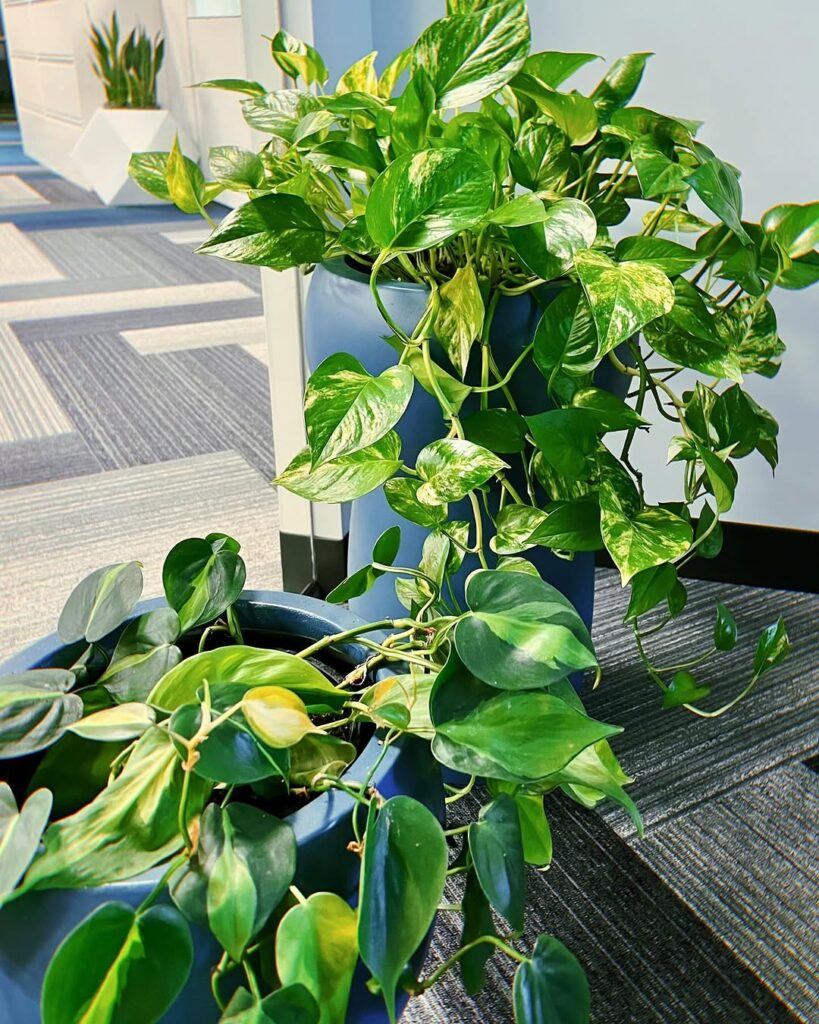
Pothos (Epipremnum aureum) is a versatile and forgiving vine that thrives in bedroom environments, making it an excellent choice for beginners. With its heart-shaped leaves and trailing growth habit, this low-maintenance plant can transform any bedroom corner into a lush retreat. Available in varieties like golden, marble queen, and neon, pothos can grow several feet long and effectively purify indoor air while requiring minimal care to flourish.
- Light: Tolerates low to bright indirect light; avoid direct sunlight; best growth in moderate indirect light
- Water: Allow top 1-2 inches of soil to dry between waterings; water less in winter
- Soil: Well-draining potting mix with added perlite
- Temperature: 60-80°F (15-27°C)
- Humidity: Adapts to normal household humidity but prefers 50-70%
- Fertilizer: Monthly feeding with balanced liquid fertilizer during growing season
- Container: Any pot with drainage holes; plastic, ceramic, or hanging baskets work well
- Pruning: Trim as needed to maintain desired length and encourage bushier growth
String of Hearts: A Delicate Cascading Beauty
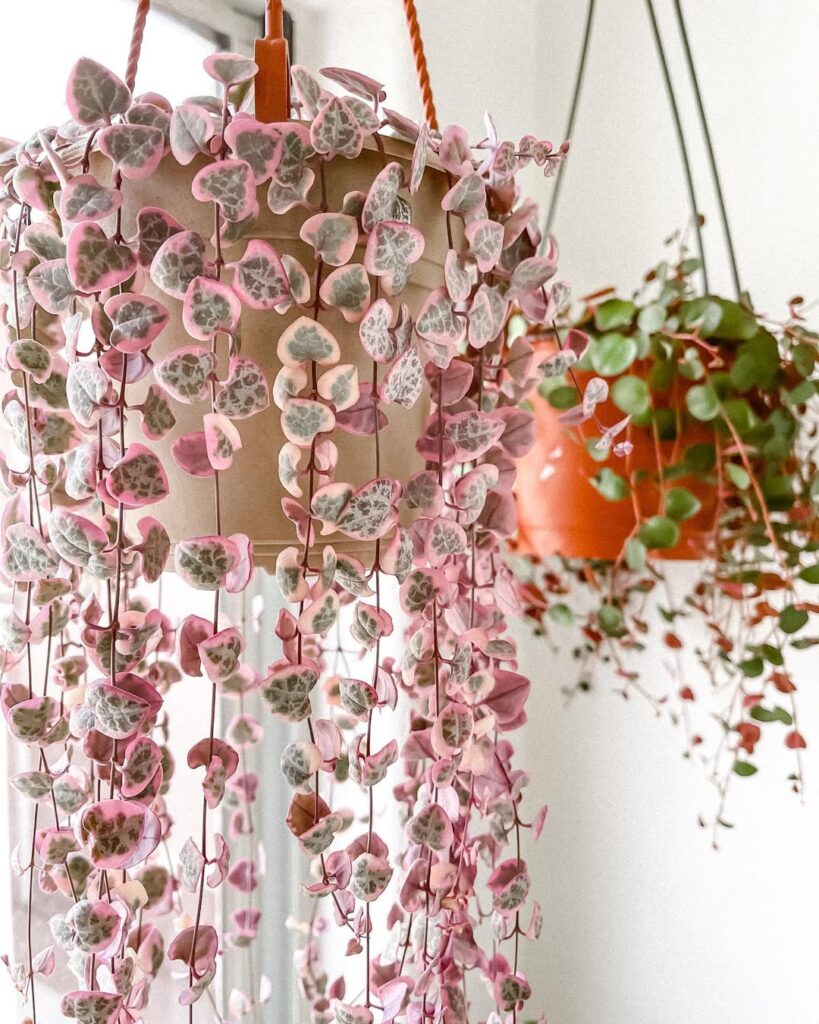
The String of Hearts (Ceropegia woodii) is a delicate trailing vine known for its charming heart-shaped leaves and dainty purple stems. This South African native features small, variegated foliage in shades of silver and green, often with purple undersides, creating an elegant cascading display that can grow several feet long. Its slender vines and diminutive leaves make it perfect for hanging baskets or high shelves in bedrooms, where its romantic appearance can add a soft, whimsical touch to the decor.
- Light: Bright, indirect light; can tolerate some direct morning sun
- Water: Allow soil to dry between waterings; reduce watering in winter
- Soil: Well-draining, sandy potting mix
- Humidity: Tolerates average household humidity levels
- Temperature: 65-80°F (18-27°C)
- Fertilizer: Light feeding during growing season (spring and summer)
- Container: Use pots with drainage holes
- Propagation: Easy to propagate from stem cuttings or tubers
English Ivy: Classic Elegance for Any Wall
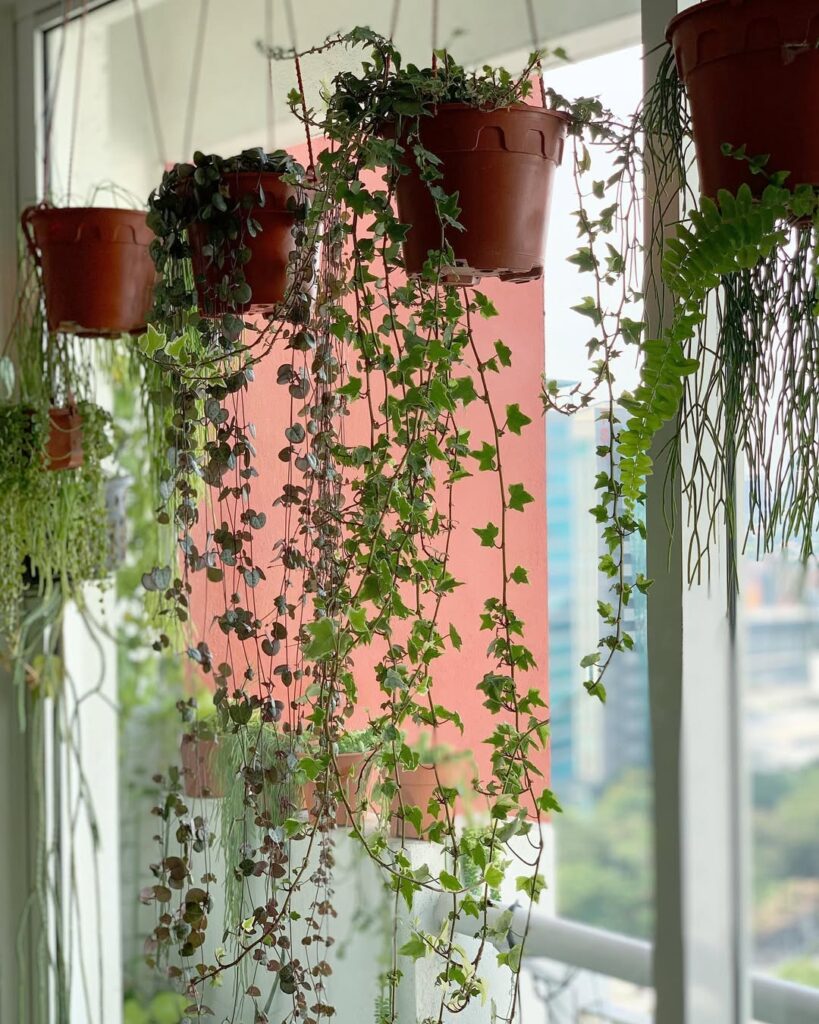
English Ivy (Hedera helix) brings timeless sophistication to bedroom walls with its deep green, pointed leaves and climbing habit. This classic vine has been adorning European architecture for centuries and can transform indoor spaces into elegant retreats. Its sturdy vines attach naturally to surfaces through aerial rootlets, creating a lush, living tapestry that can be trained to grow in various patterns while helping to purify indoor air.
- Light: Bright indirect light to partial shade; avoid direct sunlight
- Water: Keep soil consistently moist but not waterlogged; water when top inch of soil feels dry
- Soil: Well-draining potting mix rich in organic matter
- Humidity: Moderate to high; benefits from regular misting
- Temperature: 60-75°F (15-24°C)
- Fertilizer: Feed monthly during growing season with balanced liquid fertilizer
- Support: Requires trellis, stakes, or textured wall surface for climbing
Philodendron Brasil: Bold Patterns and Easy Care

Philodendron Brasil is a striking tropical vine featuring heart-shaped leaves with vibrant variegation in dark and lime green. A natural climber from the Philodendron family, this plant’s distinctive foliage displays unique patterns that can vary from leaf to leaf, creating visual interest as it trails or climbs. Its manageable growth rate and forgiving nature make it an excellent choice for both novice and experienced plant enthusiasts looking to add a bold statement piece to their indoor spaces.
- Light: Bright indirect light; can tolerate moderate light but avoid direct sun exposure
- Water: Allow top 1-2 inches of soil to dry between waterings; reduce frequency in winter
- Soil: Well-draining, rich potting mix with added perlite or orchid bark
- Humidity: Moderate to high; thrives in 50-60% humidity
- Temperature: 65-80°F (18-27°C)
- Fertilizer: Monthly feeding during growing season with balanced liquid fertilizer
- Support: Provides moss pole or trellis for climbing; can also be grown as a trailing plant
- Container: Pot with drainage holes to prevent root rot
Air Plants: No-Soil Vines for Modern Spaces
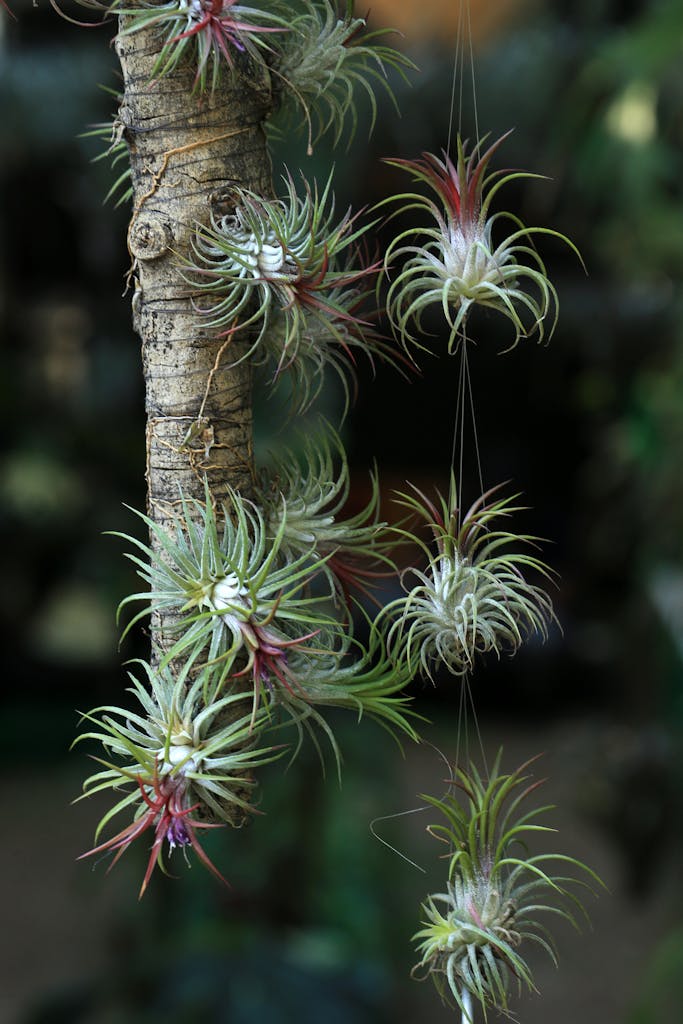
Air plants (Tillandsia) are unique vine-like specimens that don’t require soil to thrive, making them perfect additions to modern bedroom spaces. These fascinating plants absorb nutrients and moisture through their leaves rather than roots, allowing them to be displayed in creative ways such as mounted on walls, suspended in hanging glass globes, or arranged in geometric holders. Their minimal maintenance requirements and architectural forms make them particularly suitable for contemporary interior designs.
- Light: Bright, indirect sunlight; avoid direct sun which can burn leaves; can tolerate artificial light
- Water: Mist 2-3 times per week in dry environments; soak in water for 20-30 minutes every 1-2 weeks
- Humidity: Prefer 50-60% humidity; benefit from occasional misting
- Temperature: Thrive in 60-80°F (15-27°C)
- Mounting: Can be attached to cork, wood, or rock using plant-safe glue or wire
- Ventilation: Need good air circulation to prevent rot
- Fertilizer: Monthly feeding with air plant-specific fertilizer during growing season
String of Pearls: Creating Living Curtains
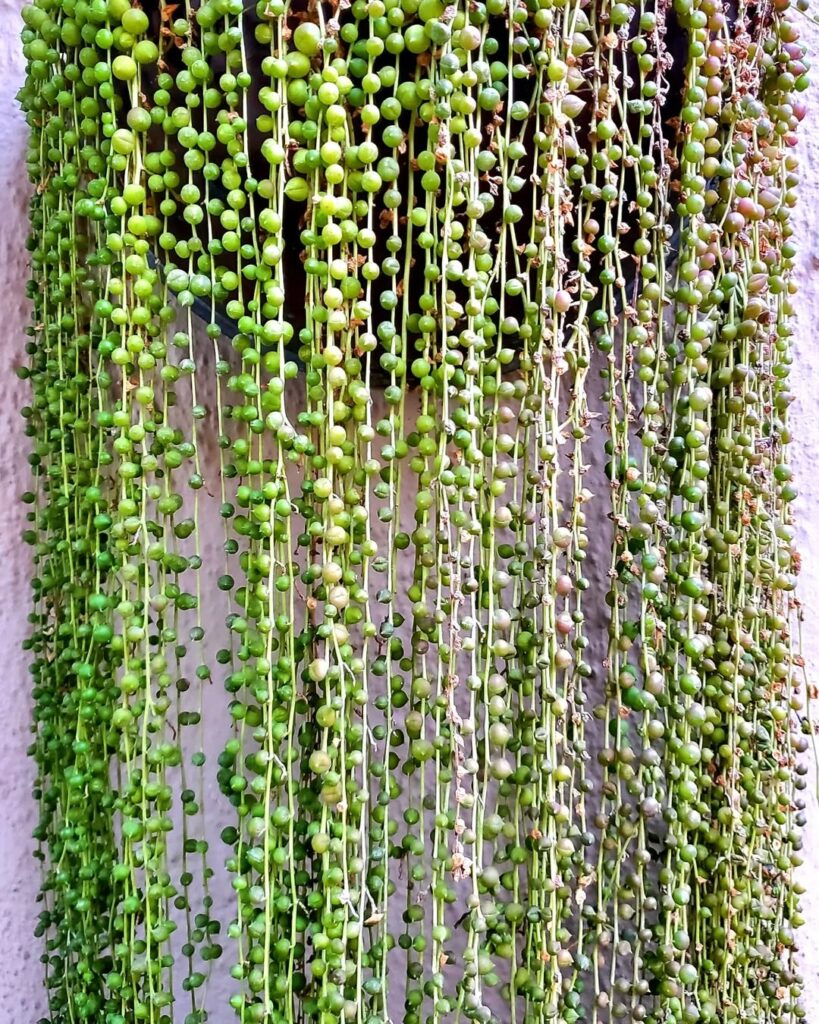
String of Pearls (Senecio rowleyanus) creates an enchanting curtain-like display with its cascading strands of small, spherical leaves that resemble a string of green pearls. When hung near windows or from ceiling hooks, these delicate vines can form living curtains that add a whimsical, organic element to bedroom decor while filtering light and providing a sense of privacy. The trailing stems can grow several feet long, making them perfect for dramatic vertical displays that transform ordinary windows into natural focal points.
- Light: Bright, indirect sunlight; morning sun is ideal; protect from harsh afternoon sun
- Water: Allow soil to dry between waterings; water thoroughly when top inch of soil feels dry
- Soil: Well-draining potting mix with added perlite or sand
- Humidity: Tolerates average room humidity; no misting required
- Temperature: 70-80°F (21-27°C); can tolerate down to 50°F (10°C)
- Container: Hanging baskets or elevated pots with drainage holes
- Fertilizer: Light feeding with balanced liquid fertilizer during growing season
- Pruning: Trim leggy stems to promote fuller growth
Wax Plant (Hoya): Sweet-Scented Climbers
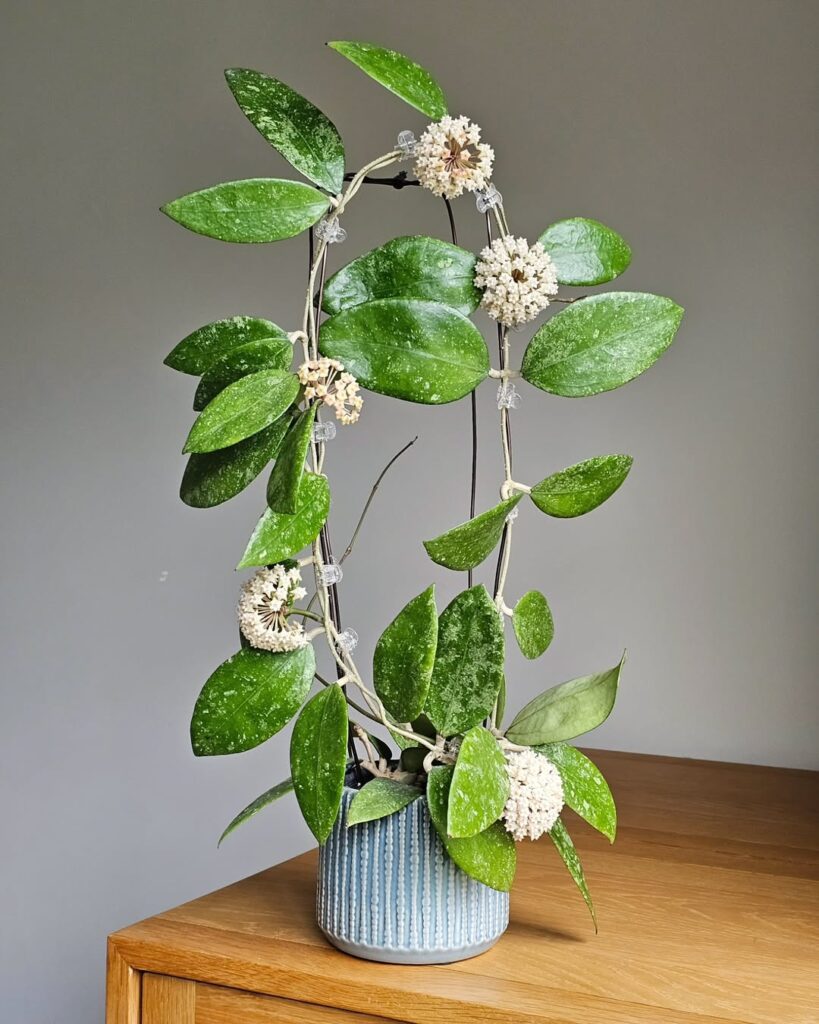
The Wax Plant, or Hoya, is a popular indoor climbing vine known for its thick, waxy leaves and clusters of star-shaped, fragrant flowers that bloom seasonally. These long-living tropical plants can grow as hanging or climbing vines, with some varieties producing delicate pink, white, or red blooms that emit a sweet fragrance, particularly in the evening. Their succulent-like leaves store water efficiently, making them relatively low-maintenance houseplants that can thrive for decades with proper care.
- Light: Bright, indirect sunlight; can tolerate some direct morning sun but avoid harsh afternoon light
- Water: Allow soil to dry between waterings; water less in winter
- Soil: Well-draining potting mix with orchid bark or perlite
- Humidity: Moderate to high (40-60%)
- Temperature: 60-80°F (15-27°C)
- Fertilizer: Feed monthly during growing season with balanced fertilizer
- Support: Provide trellis or pole for climbing varieties
- Pruning: Minimal; avoid removing old flower stalks as they produce new blooms
Spider Plant: The Indestructible Trailing Classic
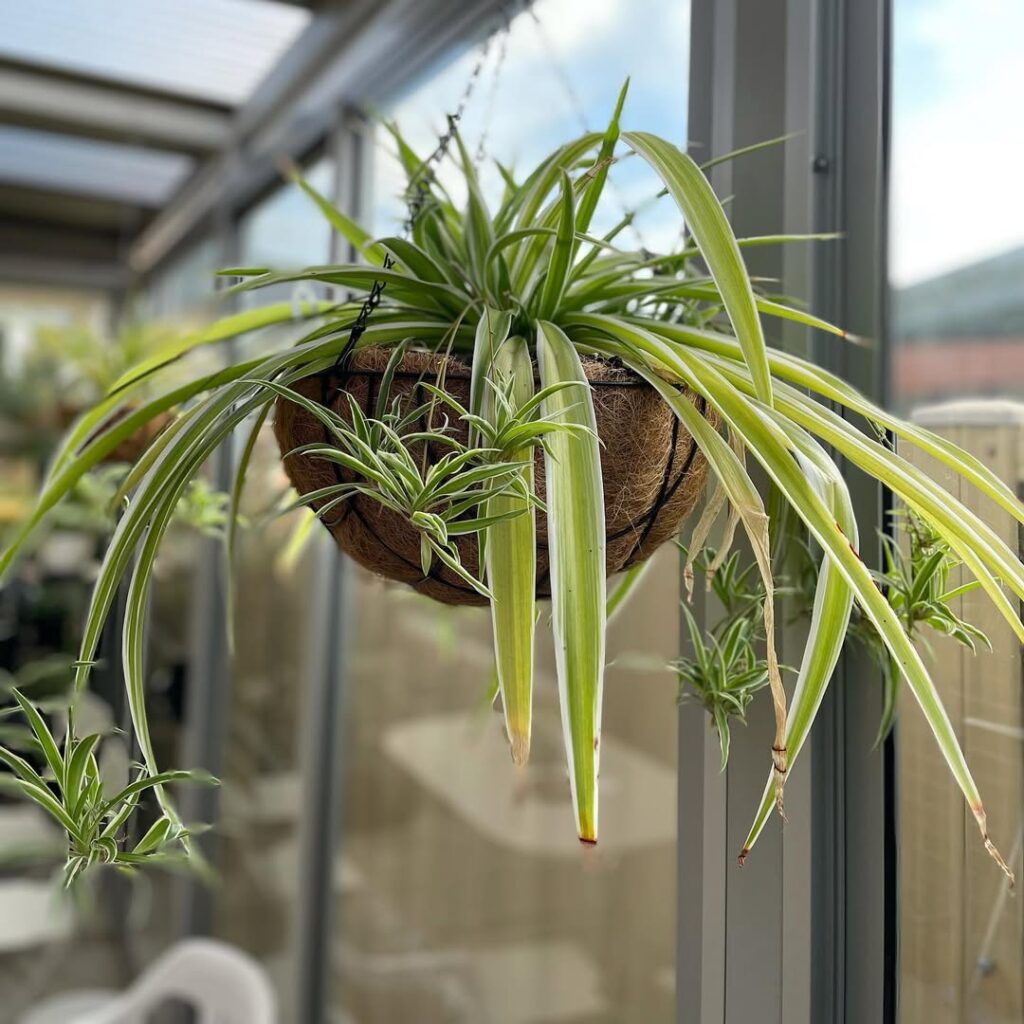
The Spider Plant (Chlorophytum comosum) is a resilient trailing plant known for its arching green and white striped leaves and ability to produce baby plantlets that dangle from long stems. This adaptable houseplant earned its “indestructible” reputation by thriving in various indoor conditions while maintaining its graceful appearance and air-purifying qualities. Its cascading growth pattern and easy propagation through its offspring make it an excellent choice for hanging baskets and elevated shelves in bedrooms.
- Light: Bright indirect light to partial shade; tolerates lower light but may lose variegation
- Water: Allow top 1-2 inches of soil to dry between waterings; tolerant of occasional underwatering
- Soil: Well-draining potting mix with good aeration
- Humidity: Adaptable to average indoor humidity levels (40-60%)
- Temperature: Comfortable in normal room temperatures between 60-75°F (15-24°C)
- Fertilizer: Light feeding with balanced houseplant fertilizer every 2-3 months during growing season
- Container: Any pot with drainage holes; ideal in hanging baskets or elevated containers
Essential Care Tips for Thriving Bedroom Vines
Essential care tips for bedroom vines focus on maintaining ideal growing conditions to help these plants flourish in indoor environments while purifying the air and adding natural beauty to your space. Proper care involves consistent monitoring of environmental factors, regular maintenance routines, and understanding each specific vine’s needs to prevent common issues like leaf yellowing, pest infestations, or stunted growth.
- Light: Most bedroom vines prefer bright, indirect sunlight; place 3-6 feet from windows; protect from harsh afternoon sun; rotate pot quarterly for even growth
- Water: Water when top 1-2 inches of soil feels dry; reduce watering in winter; avoid overwatering to prevent root rot; mist regularly to maintain humidity
- Soil: Well-draining potting mix rich in organic matter; pH between 6.0-6.5; repot every 2-3 years or when roots become crowded
- Temperature: Maintain 65-80°F (18-27°C); protect from cold drafts and air conditioning vents
- Fertilizer: Apply balanced liquid fertilizer monthly during growing season; reduce to quarterly in winter
- Pruning: Trim regularly to control size and shape; remove dead or yellowing leaves; pinch growing tips to encourage bushiness
